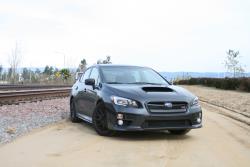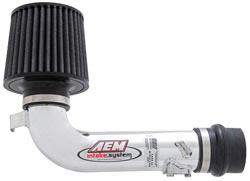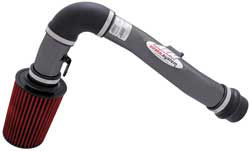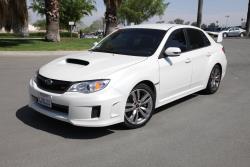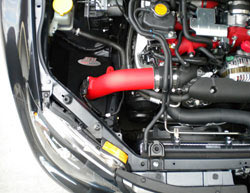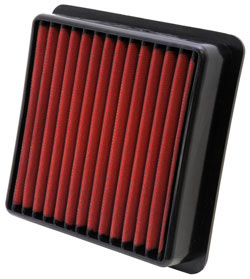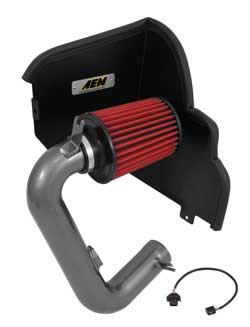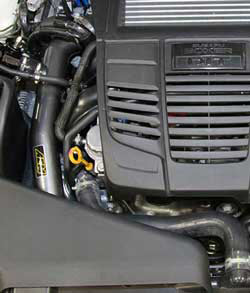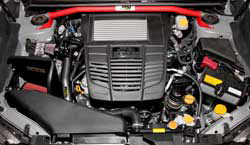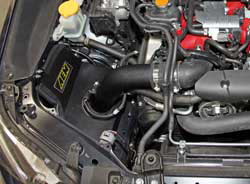Your Guide to AEM Subaru Impreza WRX Performance Parts
- Dec 1, 2
|
Launched in Japan for the 1992 model year, the GC8/GF8 Subaru Impreza WRX was a hot rodded 4WD compact that was primarily designed to be a platform for rally cars. More powerful stripped-down versions of the World Rally eXperimental soon followed (Subaru WRX Type RA, Subaru WRX STi), and they would help Subaru to dominate the world rally championship by the end of the decade. Customers around the world reveled in the little Subie's turbocharged power and all-wheel drive grip. But U.S. customers wouldn't see a USDM (United States Domestic Market) Subaru Impreza WRX until the 2nd generation GGA/GDA WRX arrived in 2002. After waiting a full decade, many people were disappointed that U.S. emission laws had forced Fuji Heavy (Subaru's parent company) to trim power in the EJ205 2.0L Boxer from 250-hp to 227-hp. Even with less power than the R.O.W. version (Rest Of the World), the USDM GGA/GDA 2002-2007 Subaru WRX could still outperform many American cars of the era. In 2004, power-hungry customers could finally get their hands on the 300-hp GDB Subaru WRX STi, and the standard WRX got the larger 230-hp Subaru EJ255 2.5L for the 2006 model year. The 3rd Generation GE7/GH7 Subaru WRX bowed for 2008, and was considerably larger than the previous generation. Although Subaru was trying to make the styling more mainstream, it was still just as quirky looking as ever. To give it a "broader appeal", the suspension was softened and the carryover EJ255 2.5L actually lost 3-hp. This "mainstreaming effort" didn't sit well with WRX fans, so Subaru wisely stiffened the suspension, and bumped the horsepower up to 265-hp for the 2009 model year. The redesigned 2008-2014 Subaru WRX STi GR8/GV8 saw power in the EJ257 2.5L intercooled turbo-4 rise to 305-hp. Several new systems were also added (Subaru Intelligent Drive (SI-DRIVE) & Multi-Mode Driver Controlled Center Differential (DCCD)) to give drivers the ability to adjust everything from the throttle response to the torque split between the axles. These controls were further enhanced for the new VA-Series Subaru WRX, which was introduced for the 2015 model year. This latest incarnation of Subaru's legendary rally car wore new muscular styling that actually managed to look good. The body structure has been stiffened, the AWD system was reengineered to provide more lateral grip, and the new 268-hp Subaru FA20F 2.0L got a Dual Active Valve Control system that increased both mid range torque and fuel efficiency. Power in the 2015-2017 Subaru WRX stays the same at 305-hp, but the new suspension, locking differentials, and big Brembo brakes helped to put the power down better than the previous generation STi. But no matter which version of this feisty Impreza you have, there are AEM Subaru WRX performance parts that can make it perform better. USDM 2002-2007 Subaru WRX GGA/GDA - GG7/GD7 It costs a lot of money to make a car comply with U.S. safety and emissions regulations. So instead of spending a fortune to retrofit a small volume sport compact, Subaru waited to import the more compliant second generation Impreza WRX. Some of the changes they had to make to the 2.0L EJ205 versus the JDM Subaru Impreza WRX motor, included ditching the big turbo, high-flow heads, and aggressive cams, for a more smog-friendly setup that's capped by a 13.6 psi Mitsubishi TD04-13T turbo. This dropped output from 250-hp to 227-hp. Fans complained about the reduced power, but Subaru rectified the power gap with the increased low-range torque of the 230-hp Subaru EJ255 2.5L in the 2006-2007 Subaru WRX GG7/GD7. To compete with the Mitsubishi Lancer Evo VII, parent company Fuji Heavy Industries decided to import the 300-hp GDB 2004-2007 Subaru WRX STi. This road rocket was loosely based on the WRX STi rally car that had won the WRC in 2001 and 2003, and it was even available with the signature blue paint and gold wheel combo. But since you can't ever have too much power, let's look at some power-mining 2002-2007 Subaru WRX performance parts from AEM.
The idea behind a cold air intake system is to increase the amount of oxygen-rich air going into the turbo compressor. Because the additional oxygen molecules in the cold air charge creates a more potent explosion inside the cylinders, which will result in extra horsepower and torque. To do this, the AEM 21-474C cold air intake ditches the OE WRX EJ205 2.0L air intake system, and relocates the air cleaner to the inside of the right front fenderwell. This allows the oversized synthetic AEM DryFlow air filter to collect a large volume of cold outside air, and send it to the motor through a wide angle aluminum intake tube. The reusable AEM air filter can remove far more dirt than the paper OE 2002-2005 Subaru WRX air filter, and it won't need to be cleaned for up to 100,000 miles (depending on road conditions). The additional airflow that it provides, will allow the turbo in your USDM Subaru Impreza WRX GGA/GDA to spool faster, so your little boxer 4cyl can deliver more torque at low RPM, and more horsepower as the revs increase. The kit is available in blue, red, and silver. AEM 22-474R Short Ram Intake System Engineered for these variations of the 2002-2007 Subaru WRX:
Reducing airflow restrictions is one of the easiest ways to increase horsepower and torque in your 2002-2007 Subaru Impreza WRX or 2004-2007 Subaru WRX STi. By design, the factory air intake system on the EJ205 2.0L, EJ255 2.5L, and EJ257 2.5L turbo actually restricts the amount of power that your little Subaru can send to all four wheels. The AEM 22-474R Short Ram Intake on the other hand, is designed to increase airflow by replacing the stock air box with a low restriction AEM DryFlow air filter. The oversized conical air filter is made from a non-oiled synthetic material. This which allows it to collect considerably more air, which can then be sent to the turbo compressor through an aluminum intake tube that features mandrel bent curves to reduce air turbulence. It also has integrated fittings for the WRX MAF sensor, and it can be ordered with and attractive red, blue, or chrome finish. Dyno testing showed an estimated increase of 11.77 horsepower. But of course, your results will depend on the modifications, mileage, and condition of your GGA/GDA Subaru WRX, GG7/GD7 Subaru WRX or GDB Subaru WRX. This kit is available in two colors: red and polished. AEM 21-477C Cold Air Intake System Engineered for these variations of the 2002-2007 Subaru WRX:
The turbocharger on your Subaru boxer engine increases horsepower by forcing more air into the cylinders, so the gasoline can burn hotter and release more energy. If you want to get more power out of your Subaru EJ255 2.5L or Subaru EJ257 2.5L, then you have to give the turbo's compressor a higher volume of cold air to send to the motor. Since cold air contains more oxygen than warm air, the gas can burn hotter during the combustion cycle, which increases the amount of horsepower and torque that the motor produces. To capture the coldest air possible, the AEM 21-477C cold air intake system positions an oversized DryFlow performance air filter inside the right front fenderwell. As you drive along, cold outside air rushes into the oil-free synthetic air filter, which then removes the fine dust and dirt from the air, before sending it into the wide-diameter intake tube. This aluminum AEM intake tube has mandrel bent curves to eliminate air turbulence and restrictions. It also has integrated fittings for that Subaru WRX MAF sensor, and you can get it in an attractive gray powder coat or polished finish. By reducing airflow restrictions and using aerodynamics to allow more air into the motor, your GDB Subaru WRX STi or GG7/GD7 Subaru WRX can make more torque at low RPMs, and more horsepower as the speed increases. Plus, this cold air intake is completely street legal in all 50 states. If you are looking for a little bling to add to your Subie, this kit also comes in a polished finish 3rd Generation 2008-2014 Subaru WRX Subaru has always been a "niche" car maker, so they wanted to use the 3rd generation Subaru Impreza WRX to attract a larger audience. That's why they made it bigger, with 'less polarizing' styling, and a softer suspension. To meet regulations, power from the Subaru EJ255 H4 was dropped back to 227-hp, which left buyers largely unimpressed by the more 'civilized' 2008 Subaru WRX. To fix the problem, Fuji Heavy gave the 2009 Subaru WRX a more sporting suspension tune, along with a bigger turbo that bumped power in the GE7/GH7 Subaru WRX up to 265-hp. The 2008-2014 Subaru WRX STi GR8/GV8 got a new top mount intercooler on the 305-hp EJ257 2.5L, and the trick AWD system made it corner like a cat on carpet. But AEM can increase the capability even more with these Subaru WRX performance parts. AEM Cold Air Intake System - GE7/GH7 2008-2014 Subaru WRX 2.5L EJ255 AEM 21-478WR Cold Air Intake
If you want to get more power from your 2008-2014 Subaru WRX, then you've got to reduce airflow restrictions so the engine can breathe. The AEM 21-478WR cold air intake is designed to eliminate airflow restrictions, and force a large volume of cold air into the motor. It does this by replacing the factory air box and intake tube, with a low restriction AEM DryFlow air filter that's positioned to draw air from outside the engine compartment. To straighten the airflow path and reduce turbulence, the narrow factory intake tube is replaced by a wide diameter aluminum intake tube that has mandrel bent curves, and fittings for all of the factory sensors. As you drive along, cold air rushes up into the filter and down the high-flow tube. By channeling outside air directly into the compressor, this 50-state legal cold air intake system creates a pre-cooled air charge that allows the EJ255 2.5L and EJ257 2.5L to make more horsepower and torque at lower RPMs. In fact, dyno testing on a 2008 Subaru WRX STi revealed an estimated increase of 36-hp. AEM 28-20304 Direct Fit DryFlow Air Filter Engineered for these variations of the 2008-2014 Subaru WRX:
If you want to improve the airflow into your 2008-2014 Subaru WRX or 2008-2014 Subaru WRX STi while simultaneously protecting your engine and warranty, then you need an AEM 28-20304 direct fit DryFlow air filter. This low restriction performance air filter is made from a special 3D synthetic material that is able to trap airborne contaminants, while significantly increasing airflow over the restrictive OE Subaru WRX air filter. The dirt then stays trapped inside the 'depth loading' material for up to 50,000 miles before cleaning is required (depending on driving conditions). AEM Strut Bar - GE7/GH7 2009-2014 Subaru WRX The idea behind the Subaru Impreza WRX, was to create an AWD sport compact that could corner like a nuclear-powered train, on rails. Thanks to its sport-tuned Subaru Symmetrical AWD system, the GE7/GH7 2009-2014 Subaru WRX has more lateral grip than many high powered exotics. But if you want to improve the cornering stability and steering response even further, then you should check out the AEM 29-0004 strut bar. It's made from 1-1/2 inch steel tubing, which offers the ideal combination of lightweight and strength. Unlike many hinged Subaru WRX strut bars, this AEM strut bar is made from one solid piece of steel, with heavy duty brackets welded to each end. This design offers superior weight transfer, which will significantly reduce chassis flex and vibration under hard cornering. It's also available with either a gray or red powder coat finish, so it will look as good under the hood, as it performs. 4rd Generation VA/FU 2015-2017 Subaru WRX 2.0L The 4th generation VA Subaru WRX and VA Subaru WRX STi, were launched for the 2015 model year, and featured a raft of new technologies. The 2015–2017 Subaru WRX got a new 268-hp FA20F 2.0L H4, that had direct injection and a twin scroll turbocharger that was mounted at the front of the engine compartment to lower the car's center of gravity. Maximum torque also came in at 2000 RPM, which greatly improved off-the-line performance. The VA Subaru WRX STi still used the EJ257 2.5L H4 from the previous generation. But ECU programming changes increased horsepower to 310, and raised the redline to dizzying 7100 RPM. And the following AEM Subaru WRX performance parts can raise the fun factor even more: AEM 21-732C Cold Air Intake If you want to get more power from your VA series Subaru WRX FA20F 2.0L H4, then you've got to send a high volume of cold air to the turbo compressor, that way it can force more oxygen rich catalyst into the cylinders. This will create a hotter fuel detonation, resulting in more horsepower and torque. To make this possible, the AEM AEM 21-732C cold air intake uses a mandrel bent aluminum intake tube, connected to an oversized AEM DryFlow performance air filter that uses the factory cold air duct to pull in cold air from outside the engine compartment. A self-sealing heat shield protects the low restriction AEM air filter from warm engine bay air, and the design of the AEM intake tube reduces air turbulence and provides a more direct airflow path to the compressor. Dyno testing of this system on a 2015 Subaru WRX revealed an estimated increase of 25-hp and 30 lb-ft of torque.
The purpose of the 2015-2017 Subaru WRX VA Series intercooler is to cool the air charge coming from the turbo, before it reaches the engine. This increases the oxygen content of the air, which allows the WRX FA20F 2.0L H4 to extract more energy (i.e. horsepower/torque) from the fuel as it burns. The air travels to the intercooler through a narrow OE Subaru FA20F 2.0L charge pipe that has tight bends and irregular surfaces that reduce airflow and cause power-robbing turbulence. An AEM 26-3000C intercooler charge pipe kit on the other hand, is made from 2-1/4 inch mandrel bent aluminum tubing, and has an integrated fitting to accommodate either the factory WRX FA20F 2.0L blow-off valve, or an aftermarket WRX FA20F 2.0L recirculating blow-off valve. If you retain the vehicle's factory recirculation valve, you will need the AEM 26-3000RK charge pipe recirculation kit. The AEM charge pipe is a considerably wider diameter than the factory charge pipe, which allows a lot more air to reach the intercooler. The wide angle mandrel bent curves provide a low restriction airflow path to reduce turbulence. And the aluminum itself will actually stabilize the air pressure coming from the turbo, that way you can get the maximum benefit from an AEM 21-732C cold air intake. AEM 29-0011WR
Thanks to a stiffened chassis, and a new version of the Subaru Symmetrical AWD system that now features Active Torque Vectoring, your VA Series 2015-2017 Subaru WRX can dispatch curves with astounding precision. The VA Series 2015-2017 Subaru WRX STi takes the handling one step further, with a track-tuned suspension, more communicative hydraulic steering, and a new Driver-Controlled Center Differential (DCCD). But no matter which version you have, the handling can still be improved upon with an AEM 29-0011WR strut bar. To do this, the AEM strut bar uses a single piece design for increased rigidity. It's made from 1-1/2 inch steel tubing for reduced weight and increased strength. The welded steel mounting brackets won't flex under pressure. And that's important, because this Subaru WRX strut bar is designed to transfer weight from one strut tower to the other as you go around curves. Under normal circumstances, the strut towers can move as much as 1/8 inch up or down during this weight transfer. However, if you connect the two strut towers, you'll reduce this chassis flex and the resulting vibration. This simple modification will yield flatter cornering, and better steering response. Plus, it comes in an attractive red powder coat finish, which will look fantastic under the hood. AEM 21-735WB Cold Air Intake System - VA Series 2015-2017 Subaru WRX STi EJ257 2.5L If you're driving a 4th generation 2015-2017 Subaru WRX STi, then you obviously enjoy turning horsepower into "extreme velocity". 310-hp comes standard in the VA Subaru WRX STi EJ257 2.5L, but if that isn't enough, an AEM 21-735WB cold air intake can help. It replaces the restrictive WRX STI air box with a low restriction AEM DryFlow air filter, which is positioned to draw cold outside air from beneath the engine compartment, while a ruggedized heat shield prevents hot engine air from entering the system. Once the air has been cleaned by oversized synthetic DryFlow air filter, it travels to the turbo through a wide diameter aluminum intake tube. Mandrel bent curves are used to reduce air turbulence, and there's even an integrated fitting for the factory MAF sensor. Thanks to this high-flow design, the AEM 21-735WB cold air intake showed an estimated increase of 32-hp and 31 lb-ft of torque when we dyno tested it on a 2015 Subaru WRX STi EJ257 2.5L. However, your results will depend on the condition, mileage, and modifications that have been done to your VA Subaru WRX STi. If you want something other than a black intake pipe, AEM also offers the 21-735WR, which comes in red.
|
||||||||||||
|
|
||||||||||||
|
||||||||||||
|
|
||||||||||||

